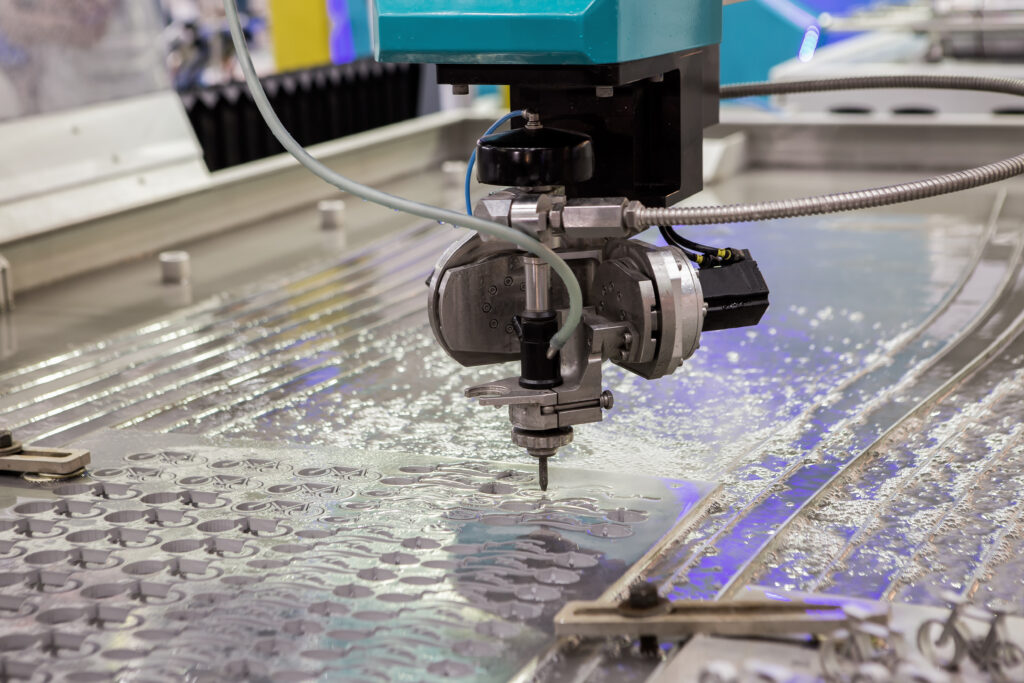
In a world where fabrication shops are working hard to diversify their clients, waterjet cutting provides a definite edge. Cost-efficient, versatile, and eco-friendly, it’s one of the most accurate and precise cutting processes out there. Plus, it can be used to cut both hard and soft materials including titanium, stainless steel aluminum, stone, marble, glass, foam, rubber, and insulation.
How Does Waterjet Cutting Work?
Waterjet cutting is a powerful and versatile tool that provides high-quality, precise cuts by firing highly pressurized water through a ruby or diamond nozzle into a mixing chamber. This creates a vacuum which draws garnet sand into the jet. This mixture is then fired at the object in place for cutting. The abrasive sand particles in the pressurized water, when directed at the material to be cut, cause an erosive effect that creates the cut.
What are the Benefits of Waterjet Cutting?
Versatility
It’s not an exaggeration to say that these cutters can cut through virtually any material. Traditional methods are only used to cut metals, but this cutting process not only works very well on metals but also on glass, wood, foam, and much more.
Superior Edge Quality
One of the biggest benefits of waterjet cutting is the quality of the edge it provides. With its small-diameter cutting stream (approximately 0.040 to 0.050 in.), the equipment creates tight corners with high tolerances. Internal cutouts like custom patterns, decorative designs, and logos can be manufactured easily using this process.
Accuracy
Because the process uses such a narrow beam of water, it has an extremely low tolerance (shift in the position of an intended cut.)
No Secondary Finishing
Waterjet cutting is also a cold cutting process, so there are no heat-affected areas or burned edges. The process does not leave any visible stains behind. There is no need for the time and expense involved in secondary operations.
Consistency
This cutting process doesn’t require the fabricator to change their tooling when inserting a new workpiece or even a new material. When cutting a new workpiece from the same material, there is no need to change any settings. When using a new material, any settings that need to change can be adjusted through the software programmed into the waterjetting equipment. The characteristics of the process preserve the integrity of every workpiece, ensuring that the cuts are consistently in the same location throughout the job.
Efficiency
Waterjet cutting makes it possible to cut multiple layers of material simultaneously by stacking them on top of each other. Imagine the time you could save cutting up to six layers at a time!
Flexibility
The thickness of the material you can cut with waterjets depends on which method you choose. Using abrasive waterjet cutting, you can cut through up to 12 inches (30 cm) of most materials—things like carbon and stainless steel. The cutting equipment that incorporates advanced abrasives into the jet stream can tackle even thicker materials.
Abrasive Cutting
In normal conditions, an abrasive waterjet machine can cut through 12 inches (30 cm) of most materials such as stainless steel and carbon steel. For example, waterjet cutters can cut through 9 inches of stainless steel. Waterjet cutting equipment that incorporates advanced abrasives can cut through 18-inch steel blocks.
Pure Cutting
Use pure waterjet cutting to cut through softer materials like foam, rubber, and paper. Even cutting foam and paper that are a few feet thick are no problem for a pure cutter.
Durability
Compared to traditional methods of cutting, waterjet cutting is extremely durable. Whereas the parts of traditional Electrical Discharge Machines (EDM) wear out quickly, waterjet cutting parts typically last thousands of hours.
Eco-Friendly
The pressurized water used in the process is recycled and the metal resulting from the cut and strained through the water is sold as scrap—making the process an environmentally friendly one.
Cutting sheet metal and plate helped build our business. At EDCO fabrication, we continue to partner with manufacturing partners in need of those materials using traditional methods. At the same time, we’re aware that the cutting on non-metals appears to be the wave of the future. We see more architects incorporating more class into their residential and commercial designs. Some of our clients, including those in the aerospace industry, are beginning to rely more on composite materials for innovative product development. For these clients and others who want to consider the waterjetting process for their needs, EDCO fabrication has the latest technology available.
